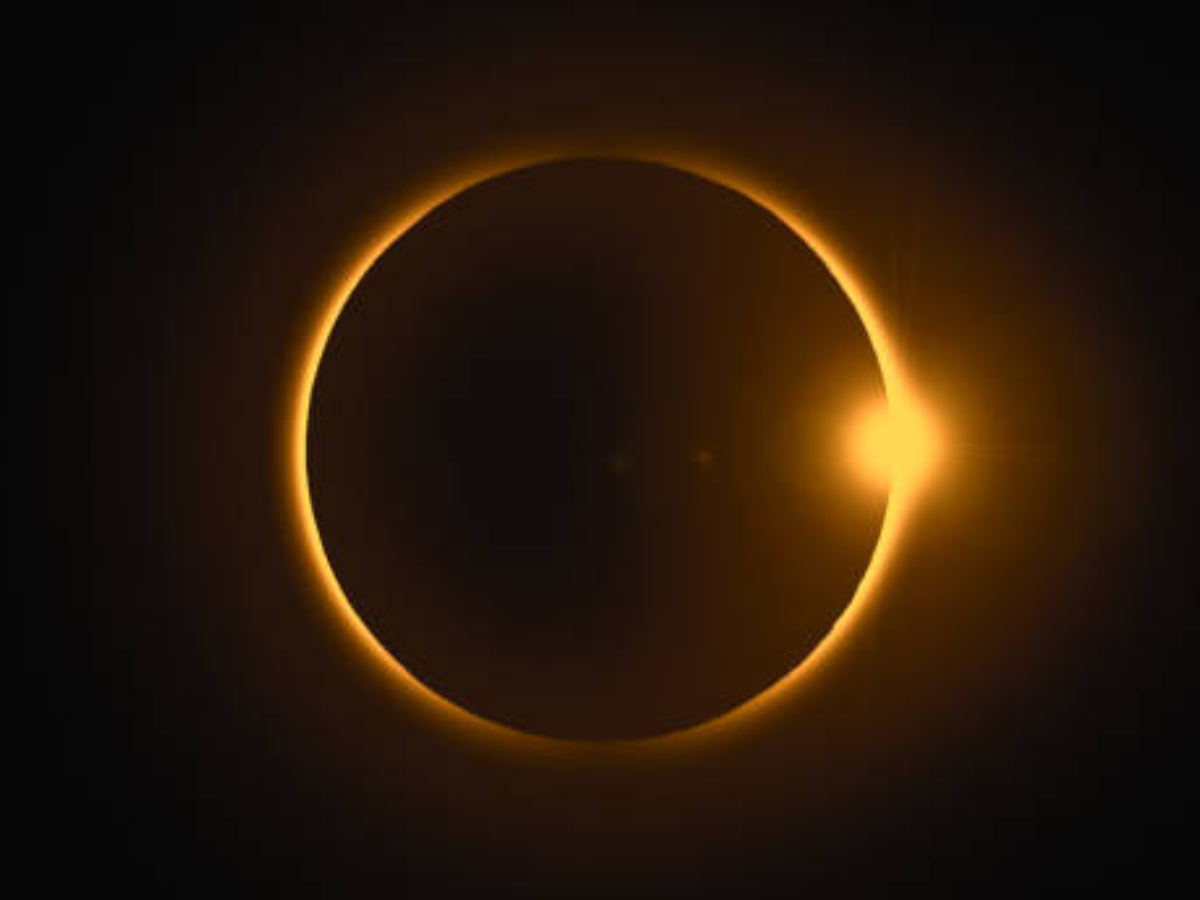Solar Eclipse 2023: What are effects of Surya Grahan on your health

A rare hybrid solar eclipse will occur on April 20 and as per NASA it will be visible to skywatchers in Australia and parts of southeast Asia as it will pass over the Indian and Pacific Oceans.
This solar eclipse is considered to be a rare celestial event as it will appear different from different locations across the globe, the space.com explains. "But this eclipse will be a much rarer celestial event than most, as it will be a hybrid eclipse that appears different from different locations across the globe taking the form of an annular eclipse, a total eclipse, or a partial eclipse," it says on its website. While Papua New Guinea will see 87% of the sun blocked, the French Southern Territories and Marshall Islands will see it almost eclipsed.
The hybrid solar eclipse will be partially visible to Australia, Southeast Asia, Antarctica.
See more: Solar Eclipse 2023 Live: Surya Grahan begins, timings, Live stream in India
The oldest record of an eclipse is on November 30, 3340, BCE. In early days, people used to say that the Sun has been eaten or the Sun has been attacked by demons.
During the solar eclipses, people are always warned not to look at the Sun directly. Health advisories are issued to not allow children and older individuals to step out during the eclipse duration.
NASA recommends eye safety measures to be followed during the solar eclipse. It urges people to not look directly at the Sun during the eclipse without any eye protection. "Viewing any part of the bright Sun through a camera lens, binoculars, or a telescope without a special-purpose solar filter secured over the front of the optics will instantly cause severe eye injury," it warns.
Viewing this with naked eyes can damage the retina. Also known as eclipse blindness it can also cause permanent damage to the eyes.
As per experts the damage associated due to staring at the Sun with naked eyes mostly starts 12 hours after seeing the eclipse. People start noticing alterations in their vision after their normal work starts getting affected due to loss of vision.
People can use handheld solar viewers to watch the eclipse.
The glasses intended to watch solar eclipses differ from regular glasses; one should not use sunglasses to view the sun. Even if you are using solar viewers make sure they comply with the ISO 12312-2 international standard and are not torn or scratched.
One can also see the eclipse using a pinhole projector. "One way is to use a pinhole projector, which has a small opening (for example, a hole punched in an index card) and projects an image of the Sun onto a nearby surface. With the Sun at your back, you can then safely view the projected image. Do NOT look at the Sun through the pinhole!," NASA explains.
Only when the moon completely blocks the Sun, which happens for a brief period, one can see the eclipse directly without any eye protection. "You’ll know it’s safe when you can no longer see any part of the Sun through eclipse glasses or a solar viewer," explains NASA.
The eclipse will be livestreamed on NASA's YouTube and Twitch channels, it has informed publicly through its Instagram post.
NASA also urges people to take care of their skin by wearing sunscreen, hat and protective clothing to prevent skin damage as the Sun is at its brightest during the eclipse.
On October 14, 2023 the world would witness an annular solar eclipse and a total solar eclipse will be seen on April 8, 2024. The annular solar eclipse will be visible to North America, Central America, and South America and will be partially visible to Africa, North America, South America, Pacific Ocean, Atlantic Ocean and Arctic Ocean. There are two partial solar eclipses in 2025 and a total solar eclipse will occur on August 23, 2044.
This solar eclipse is considered to be a rare celestial event as it will appear different from different locations across the globe, the space.com explains. "But this eclipse will be a much rarer celestial event than most, as it will be a hybrid eclipse that appears different from different locations across the globe taking the form of an annular eclipse, a total eclipse, or a partial eclipse," it says on its website. While Papua New Guinea will see 87% of the sun blocked, the French Southern Territories and Marshall Islands will see it almost eclipsed.
The hybrid solar eclipse will be partially visible to Australia, Southeast Asia, Antarctica.
Apart from the scientific importance, solar eclipse is of immense religious significance in India. Popularly referred to as Surya Grahan, on solar eclipse Indians follow several rules which includes abstaining from consuming food and drink till the solar eclipse is over. However, there is no scientific approval for these practices. Though such celestial events have been occurring since time immemorial, people have different reactions and interpretations to their occurrences.
See more: Solar Eclipse 2023 Live: Surya Grahan begins, timings, Live stream in India
The oldest record of an eclipse is on November 30, 3340, BCE. In early days, people used to say that the Sun has been eaten or the Sun has been attacked by demons.
During the solar eclipses, people are always warned not to look at the Sun directly. Health advisories are issued to not allow children and older individuals to step out during the eclipse duration.
NASA recommends eye safety measures to be followed during the solar eclipse. It urges people to not look directly at the Sun during the eclipse without any eye protection. "Viewing any part of the bright Sun through a camera lens, binoculars, or a telescope without a special-purpose solar filter secured over the front of the optics will instantly cause severe eye injury," it warns.
Viewing this with naked eyes can damage the retina. Also known as eclipse blindness it can also cause permanent damage to the eyes.
As per experts the damage associated due to staring at the Sun with naked eyes mostly starts 12 hours after seeing the eclipse. People start noticing alterations in their vision after their normal work starts getting affected due to loss of vision.
People can use handheld solar viewers to watch the eclipse.
The glasses intended to watch solar eclipses differ from regular glasses; one should not use sunglasses to view the sun. Even if you are using solar viewers make sure they comply with the ISO 12312-2 international standard and are not torn or scratched.
One can also see the eclipse using a pinhole projector. "One way is to use a pinhole projector, which has a small opening (for example, a hole punched in an index card) and projects an image of the Sun onto a nearby surface. With the Sun at your back, you can then safely view the projected image. Do NOT look at the Sun through the pinhole!," NASA explains.
Only when the moon completely blocks the Sun, which happens for a brief period, one can see the eclipse directly without any eye protection. "You’ll know it’s safe when you can no longer see any part of the Sun through eclipse glasses or a solar viewer," explains NASA.
The eclipse will be livestreamed on NASA's YouTube and Twitch channels, it has informed publicly through its Instagram post.
NASA also urges people to take care of their skin by wearing sunscreen, hat and protective clothing to prevent skin damage as the Sun is at its brightest during the eclipse.
On October 14, 2023 the world would witness an annular solar eclipse and a total solar eclipse will be seen on April 8, 2024. The annular solar eclipse will be visible to North America, Central America, and South America and will be partially visible to Africa, North America, South America, Pacific Ocean, Atlantic Ocean and Arctic Ocean. There are two partial solar eclipses in 2025 and a total solar eclipse will occur on August 23, 2044.
- When is the solar eclipse?
The solar eclipse is expected to occur on April 20. - What is rare hybrid solar eclipse?
A hybrid eclipse appears different from different locations across the globe taking the form of an annular eclipse, a total eclipse, or a partial eclipse, the space.com has explained. - Where will the solar eclipse be visible?
As per NASA the solar eclipse will be visible in Australia and some parts of Southeast Asia. - How should one see the solar eclipse?
One should use solar flares to see the eclipse and can also watch the livestream on NASA's YouTube link. - How should one take care of eyes during eclipse?
NASA has warned not to see the eclipse with naked eyes as it can damage the retina. - Should I take care of my skin too during solar eclipse?
It is recommended to use sunscreen and wear long sleeve clothes if you are stepping out during this time.






















All Comments ()+^ Back to Top
Refrain from posting comments that are obscene, defamatory or inflammatory, and do not indulge in personal attacks, name calling or inciting hatred against any community. Help us delete comments that do not follow these guidelines by marking them offensive. Let's work together to keep the conversation civil.
HIDE